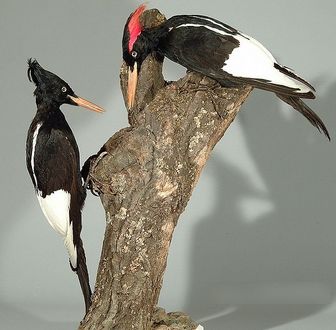Imperial woodpecker
The male had a red-sided crest, but was otherwise black, apart from the inner primaries, which were white-tipped, white secondaries, and a white scapular stripe which unlike in the Ivory-billed Woodpecker did not extend on the neck. The female was similar but the crest was all black and recurved at the top. It was once widespread and, until the early 1950s, not uncommon throughout the Sierra Madre Occidental of Mexico, from western Sonora and Chihuahua southwards to Jalisco and Michoacan.

Original source: Own work
Author: Fritz Geller-GrimmPermission(Reusing this file)I, the copyright holder of this work, hereby publish it under the following license: This file is licensed under the Creative Commons Attribution-Share Alike 2.5 Generic license.You are free:to share – to copy, distribute and transmit the work
The Imperial woodpecker is classified as Critically Endangered (CR), facing an extremely high risk of extinction in the wild.
The Imperial Woodpecker (Campephilus imperialis) is or was a majestic member of the woodpecker family Picidae. Due to its close relationship and similarity to the Ivory-billed Woodpecker, it is sometimes also called "Mexican Ivorybill" but this name is also used for the Pale-billed Woodpecker. If it is not extinct, it is the world's largest woodpecker species. More
The Imperial Woodpecker is officially listed as Critically Endangered (possibly extinct) by the IUCN. However, the last confirmed report was of a recently-shot bird in Durango in 1956 and the species is probably now extinct. The primary reason for its decline was loss of habitat, although the decline was also accelerated by over-hunting for use in folk medicine and because nestlings were considered a delicacy at least by the Tarahumara. More
The imperial woodpecker is the largest woodpecker species in the world. Unfortunately, it is believed to be extinct since it has not been seen since the 1950s. There have since been only three unconfirmed sightings by Mexican natives. This bird was once found only in Mexico's western mountain ranges - the Sierra Madre Occidental and the Central Volcanic Belt. Adults reached about 23 inches long. More
and credible sightings of the Imperial Woodpecker Profiles of Birds E-mail Article to a Friend Print Article Bookmark and Share Description, range, habits, and credible sightings of the Imperial Woodpecker = Is the larger, grander cousin of our Ivory-billed Woodpecker - the Imperial Woodpecker - still flying in western Mexico?By Matt Mendenhall Published: January 23, 2006 Last spring's announcement of the apparent rediscovery of the Ivory-billed Woodpecker shocked More
Original distributions of the Imperial Woodpecker and the area for which the present status of the pine-oak forest has been assessed Figure 2. Potential areas for the Imperial Woodpecker that showed up in an analysis of 1:250,000 topographical maps Figure 3. Original area of pine-oak forest in the Sierra Madre Occidental Figure 4. Remaining old-growth pine-oak forest in October 1995 Figure 5. More
Imperial woodpeckers, perhaps the most endangered birds in the world (if not extinct), have historically occupied the montane hardwood forests of West Mexico. The Imperial Woodpecker of Mexico, critically endangered or extinct, is (was) the largest woodpecker in the world. More
a bird which could be a female Imperial Woodpecker, claiming that they observed that bird for two minutes on a pine at Divisadero on the north rim of Copper Canyon (Barranca del Cobre), Mexico. This sighting has not been confirmed. The Imperial Woodpecker's closest relative is the similar but 20% smaller Ivory-billed woodpecker, which is also critically endangered or extinct. Copyright: Wikipedia. This article is licensed under the GNU Free Documentation License. It uses material from Wikipedia. More
Aspects of the topic imperial woodpecker are discussed in the following places at Britannica. Assorted References * possible extinction (in ivory-billed woodpecker (bird); ...A subspecies, the Cuban ivory-billed woodpecker (Campephilus principalis bairdii), was last officially sighted in the late 1980s and is believed to be extinct. A related species, the imperial woodpecker (C. More
United States and Cuba and the Imperial Woodpecker of western Mexico are larger.) It has a black body, a red crest, white stripes on its neck and black and white stripes on its face. It has yellow bristly feathers over its nostrils that keep out wood chips. It has a long, sticky tongue; a long, sharp pointed bill and yellow eyes. Males and females are similar, but males have a red forehead, and females have a gray to yellowish brown forehead. More
The Imperial Woodpecker (Campephilus imperialis) was or is the world’s largest species of woodpecker; yes, it is even grander than its often-discussed relative, the ivory-billed woodpecker. Measuring up to 22 inches (60 cm) long, they are a striking bird. The males have a red crest, but otherwise are black, apart from the inner primaries, which are white-tipped, and white secondaries. The females are similar in appearance but the crest is black, not red. More
Imperial Woodpecker - 3D View at Naturalis Naturalis is the website of the National Museum of Natural History in the Netherlands. At Naturalis, you can find 3D images of specimens from the Zoological Museum of the University of Amsterdam including an Imperial Woodpecker, a Cuban Ivory-billed Woodpecker and a US Ivory-billed Woodpecker . More
imperial woodpecker of Mexico, is critically endangered. All these birds appear to have required large trees and isolation from disturbance. For more information on ivory-billed woodpecker, visit Britannica.com. Columbia Encyclopedia: ivory-billed woodpecker - Top Home > Library > Miscellaneous > Columbia Encyclopediaivory-billed woodpecker, common name for the largest of the North American woodpeckers, Campephilus principalis. More
I would like to see a survey for the Imperial Woodpecker at the southern end of its historical range in Michoacan, which seems to have been ignored. Also needed is a survey in the sierra del Carmen near the Texas Big Bend, where Roland H. More

Family : Picidae
Genus : Campephilus
Species : imperialis
Authority : (Gould, 1832)

